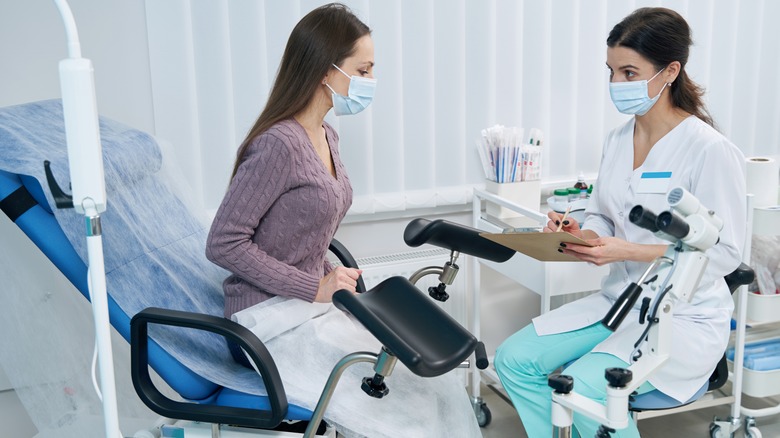Why Endometriosis Can Be So Hard To Treat
Endometriosis is a condition that is estimated to affect as many as 10% of women, yet it remains one of the most misunderstood and underdiagnosed conditions, according to a 2020 study published in the journal Diagnosis. If you have this condition, some days can be a struggle filled with frustration and uncertainty. Furthermore, a misdiagnosis can leave you suffering in silence with debilitating pain and infertility — two well-known symptoms of the condition. Unfortunately, the exact cause of endometriosis is not fully understood.
In those with endometriosis, tissue similar to the lining of the uterus grows outside of the uterus, often on the ovaries, fallopian tubes, or other areas in the pelvic region, per Johns Hopkins Medicine. In addition to causing pain, the tissue, known as endometrial tissue, can cause inflammation and scarring. The condition is more common in women who have a family history of endometriosis, and may also be caused by reverse menstruation — this is when tissue isn't evacuated from the body during one's period, but instead travels elsewhere in the body, such as the fallopian tubes.
Although the symptoms of endometriosis are well known, the condition can sometimes be hard to treat for various reasons.
Endometriosis can be hard to diagnose
One of the main challenges with endometriosis is that it can be difficult to diagnose. According to a 2019 study published in the American Journal of Obstetrics and Gynecology, endometriosis can take anywhere between 4 and 11 years to diagnose. Furthermore, six out of 10 women with the condition may be undiagnosed. One main reason for misdiagnosis is that the severity of symptoms does not necessarily correspond to the severity of the condition. Some women with endometriosis may be asymptomatic — even those with more extensive endometrial tissue growth may have very few symptoms, says the UT Health East Texas.
Another challenge with diagnosing the condition is that endometriosis symptoms can be similar to those of other conditions, per the Circle Health Group. This can make it difficult to distinguish endometriosis from other conditions based on symptoms alone.
Additionally, no single test can definitively diagnose endometriosis, explains Live Science. The gold standard for diagnosing endometriosis is currently a laparoscopy, a procedure in which a small camera is inserted through a small incision in the abdomen to view the pelvic area and look for signs of endometrial tissue. However, this procedure is not always practical given that it is invasive, can lead to complications, and may not even work to identify many cases where endometrial lesions are deep or hard to locate.
No single treatment works for everyone
Once endometriosis has been diagnosed, treatment can be challenging for several reasons. First, no single method works for everyone, and a treatment plan can depend on many factors, including symptoms and age, according to Johns Hopkins Medicine. Treatment often involves a combination of approaches, such as pain management, hormonal treatments, and laparoscopic surgery. However, even with these approaches, some women may still experience persistent symptoms since no guaranteed lasting treatment is available. Removing scar tissue via surgery may only provide temporary relief, as the pain might return.
Additionally, much is still not understood about endometriosis and its underlying causes. While researchers have identified several potential risk factors, such as family history, the exact cause of endometriosis is still not fully understood, says the Cleveland Clinic. This can make developing new and more effective treatments for the condition challenging.
Despite these challenges, there is ongoing research into the causes and management of endometriosis. If you have endometriosis, it's always best to work closely with your doctor, who can develop a treatment plan tailored to your symptoms.



